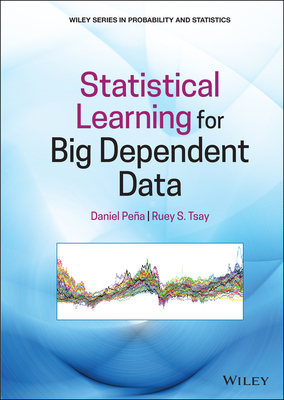Beginning Mathematica and Wolfram for Data Science: Applications in Data Analysis, Machine Learning, and Neural Networks
暫譯: 數據科學入門:Mathematica 與 Wolfram 在數據分析、機器學習及神經網絡中的應用
Villalobos Alva, Jalil
- 出版商: Apress
- 出版日期: 2021-02-02
- 售價: $2,060
- 貴賓價: 9.5 折 $1,957
- 語言: 英文
- 頁數: 390
- 裝訂: Quality Paper - also called trade paper
- ISBN: 1484265939
- ISBN-13: 9781484265932
-
相關分類:
Data Science、Machine Learning
海外代購書籍(需單獨結帳)
買這商品的人也買了...
-
 $1,068Cryptography and Network Security, 4/e (IE) (美國版ISBN:0131873164) (平裝)
$1,068Cryptography and Network Security, 4/e (IE) (美國版ISBN:0131873164) (平裝) -
 Mastering Regular Expressions, 3/e (Paperback)
Mastering Regular Expressions, 3/e (Paperback)$1,881$1,782 -
 C# 4.0 Pocket Reference, 3/e (Paperback)
C# 4.0 Pocket Reference, 3/e (Paperback)$790$751 -
 $199Fitness for Geeks: Real Science, Great Nutrition, and Good Health (Paperback)
$199Fitness for Geeks: Real Science, Great Nutrition, and Good Health (Paperback) -
 Semantic Information Processing (Paperback)
Semantic Information Processing (Paperback)$1,410$1,340 -
 The Essential Knuth (Paperback)
The Essential Knuth (Paperback)$770$732 -
 Geeks Bearing Gifts (Paperback)
Geeks Bearing Gifts (Paperback)$1,050$998 -
 Possiplex (Paperback)
Possiplex (Paperback)$1,510$1,435 -
 A New Kind of Science
A New Kind of Science$2,120$2,014 -
 The Art of Computer Programming, Volume 4B, Fascicle 5 : Mathematical Preliminaries Redux; Backtracking; Dancing Links (Paperback)
The Art of Computer Programming, Volume 4B, Fascicle 5 : Mathematical Preliminaries Redux; Backtracking; Dancing Links (Paperback)$1,500$1,425 -
 ChatGPT 指令大全與創新應用:GPT-4 搶先看、串接 API、客服機器人、AI英文家教,一鍵打造 AI智慧產品
ChatGPT 指令大全與創新應用:GPT-4 搶先看、串接 API、客服機器人、AI英文家教,一鍵打造 AI智慧產品$680$530 -
 AI 繪圖夢工廠 :Midjourney、Stable Diffusion、Leonardo. ai × ChatGPT 超應用 神技
AI 繪圖夢工廠 :Midjourney、Stable Diffusion、Leonardo. ai × ChatGPT 超應用 神技$630$498 -
 ChatGPT 開發手冊 - 用 OpenAI API ‧ LangChain ‧ Embeddings 設計 Plugin、LINE/Discord bot、股票分析與客服自動化助理
ChatGPT 開發手冊 - 用 OpenAI API ‧ LangChain ‧ Embeddings 設計 Plugin、LINE/Discord bot、股票分析與客服自動化助理$750$593
商品描述
Enhance your data science programming and analysis with the Wolfram programming language and Mathematica, an applied mathematical tools suite. The book will introduce you to the Wolfram programming language and its syntax, as well as the structure of Mathematica and its advantages and disadvantages.
You'll see how to use the Wolfram language for data science from a theoretical and practical perspective. Learning this language makes your data science code better because it is very intuitive and comes with pre-existing functions that can provide a welcoming experience for those who use other programming languages.
You'll cover how to use Mathematica where data management and mathematical computations are needed. Along the way you'll appreciate how Mathematica provides a complete integrated platform: it has a mixed syntax as a result of its symbolic and numerical calculations allowing it to carry out various processes without superfluous lines of code. You'll learn to use its notebooks as a standard format, which also serves to create detailed reports of the processes carried out.
What You Will Learn
- Use Mathematica to explore data and describe the concepts using Wolfram language commands
- Create datasets, work with data frames, and create tables
- Import, export, analyze, and visualize data
- Work with the Wolfram data repository
- Build reports on the analysis
- Use Mathematica for machine learning, with different algorithms, including linear, multiple, and logistic regression; decision trees; and data clustering
Who This Book Is For
Data scientists new to using Wolfram and Mathematica as a language/tool to program in. Programmers should have some prior programming experience, but can be new to the Wolfram language.
商品描述(中文翻譯)
增強您的資料科學程式設計和分析能力,使用 Wolfram 程式語言和 Mathematica,這是一套應用數學工具。這本書將介紹您 Wolfram 程式語言及其語法,以及 Mathematica 的結構和其優缺點。
您將從理論和實踐的角度了解如何使用 Wolfram 語言進行資料科學。學習這種語言可以使您的資料科學程式碼更佳,因為它非常直觀,並且提供了現成的函數,能為使用其他程式語言的人提供友好的體驗。
您將學習如何在需要資料管理和數學計算的情況下使用 Mathematica。在這個過程中,您將欣賞到 Mathematica 提供的完整整合平台:由於其符號和數值計算的混合語法,使其能夠在不需要冗餘程式碼的情況下執行各種過程。您將學會使用其筆記本作為標準格式,這也用於創建詳細的過程報告。
您將學到什麼
- 使用 Mathematica 探索資料並使用 Wolfram 語言命令描述概念
- 創建資料集,處理資料框,並創建表格
- 導入、導出、分析和可視化資料
- 使用 Wolfram 資料庫
- 建立分析報告
- 使用 Mathematica 進行機器學習,包含不同的演算法,如線性回歸、多重回歸和邏輯回歸;決策樹;以及資料聚類
本書適合誰
對使用 Wolfram 和 Mathematica 作為程式語言/工具的新資料科學家。程式設計師應具備一些先前的程式設計經驗,但可以是 Wolfram 語言的新手。
作者簡介
作者簡介(中文翻譯)
哈利爾·維拉洛博斯·阿爾瓦 是一位 Wolfram 語言程式設計師和 Mathematica 使用者。他畢業於墨西哥城的伊比利亞美洲大學,獲得工程物理學位。他的研究背景包括量子物理、生物資訊學、蛋白質組學和蛋白質設計。他的學術興趣涵蓋量子技術、生物資訊學、機器學習、隨機過程和太空工程等主題。在閒暇時間,他喜歡踢足球、游泳和聽音樂。






























